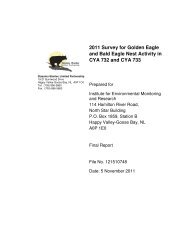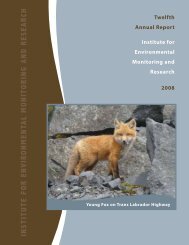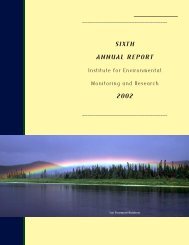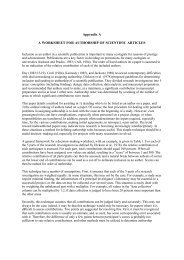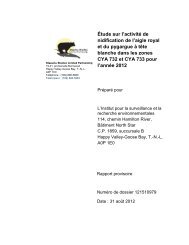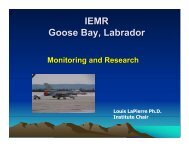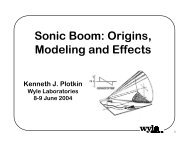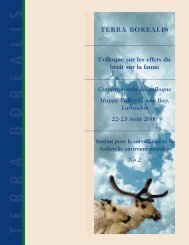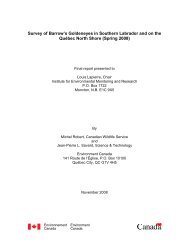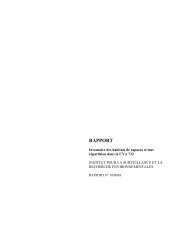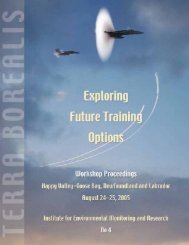2007 Annual Report - Institute for Environmental Monitoring and ...
2007 Annual Report - Institute for Environmental Monitoring and ...
2007 Annual Report - Institute for Environmental Monitoring and ...
- No tags were found...
You also want an ePaper? Increase the reach of your titles
YUMPU automatically turns print PDFs into web optimized ePapers that Google loves.
P a g e 2 4 I n s t i t u t e f o r E n v i r o n m e n t a l M o n i t o r i n g a n d R e s e a r c h 2 0 0 7 A n n u a l R e p o r tPANEL RECOMMENDATIONS GOVERNMENT DECISIONS INSTITUTE RESPONSE51. The panel recommended thatavoidance <strong>and</strong> effects monitoringprograms be integrated <strong>for</strong> the sakeof cost effectiveness <strong>and</strong> efficientproject management.52. The panel recommended that, inan attempt to ensure the bestprotection of the environment, allparties (Aboriginal, non-Aboriginal,federal, provincial <strong>and</strong> DND) areinvolved as equals in thedecision-making <strong>and</strong> review process<strong>for</strong> the monitoring program.53. The panel recommended that allparties be involved in the setting ofobjectives <strong>for</strong> the futuremonitoring program <strong>and</strong> theevaluation of acceptable levels ofimpact.Northern LabradorGovernment accepted thisrecommendation withexplanatory comment. “TheDepartment of NationalDefence will ensureintegration of the avoidance<strong>and</strong> effects monitoringprograms that it will beimplementing between now<strong>and</strong> the time the <strong>Institute</strong> isestablished. Thisrecommendation will also bereferred to the <strong>Institute</strong>”.Government accepted thisrecommendation withexplanatory comment. “An<strong>Institute</strong> <strong>for</strong> <strong>Environmental</strong><strong>Monitoring</strong> <strong>and</strong> Research willbe established. It will be anadvisory body reporting tothe Ministers of Environment<strong>and</strong> National Defence <strong>and</strong> isintended to foster a level oftrust among all groups affectedby the low-level flyingactivities…”See above comment <strong>for</strong>recommendation #52.The IEMR has proposed a revised program that would see the<strong>Institute</strong> integrate the role of avoidance <strong>and</strong> effects monitoring.The IEMR has received approval <strong>for</strong> a renewal of its activitiesuntil March 2010. The IEMR has a new m<strong>and</strong>ate, which willenable it to conduct <strong>and</strong> oversee all monitoring <strong>and</strong> effectsresearch associated with future military training.The IEMR is presently reviewing all of its monitoring <strong>and</strong>research initiatives.The IEMR has signed a revised MOU with DND that ensures thatall monitoring activities are now conducted by IEMR. The IEMRis also in the process of preparing a revised monitoring programwhich will ensure a continuous flow of monitoring data to DND.The <strong>Institute</strong> continues to explore opportunities to integrate itsresearch <strong>and</strong> monitoring activities with broad communityrepresentation <strong>and</strong> scientific participation as described in thisannual report. The IEMR is ensuring that Aboriginal groupsare kept in<strong>for</strong>med of the research initiatives of the <strong>Institute</strong>.Continuing contact with the Aboriginal communities is assuredthrough the IEMR communication <strong>and</strong> outreach program.The IEMR meets regularly with the representatives from theAboriginal communities to assess the present program <strong>and</strong> toconsider new options that will reflect the requirements of therevised training options.The IEMR is currently reviewing its communication <strong>and</strong>in<strong>for</strong>mation exchange program. A revised program will bereviewed by the IEMR Board during the coming year.IEMR is continuing to involve representatives from the Board attechnical committees <strong>and</strong> workshops.In collaboration with DND <strong>and</strong> the provincial governments, theIEMR continues to review research <strong>and</strong> set new objectives <strong>for</strong>the development of a monitoring program through its TechnicalCommittees, the SRC, community representatives <strong>and</strong>independent scientists that will reflect the changing needs ofthe flight training program.The IEMR continues to collaborate with DND, the Aboriginalcommunities <strong>and</strong> the provincial agencies from both Quebec <strong>and</strong>Newfoundl<strong>and</strong> <strong>and</strong> Labrador in order to incorporate themonitoring needs of the revised training program.The IEMR continues to meet on a regular basis with representativesfrom the governments of Quebec <strong>and</strong> Newfoundl<strong>and</strong> <strong>and</strong>Labrador to address issues of mutual concern.The IEMR also meets regularly with Aboriginal representatives toreview issues of mutual concern.The IEMR hosted two VEC workshops in <strong>2007</strong> to assess thenoise avoidance criteria that will be required to ensure that allspecies are protected from adverse noise disturbance fromfuture military training.The IEMR will review the results of the VEC workshops whichwere held in <strong>2007</strong> <strong>and</strong> assess how the noise avoidance criteriawill be integrated in the monitoring program to ensure that allimportant VECs are protected from adverse noise disturbanceduring future military training.



